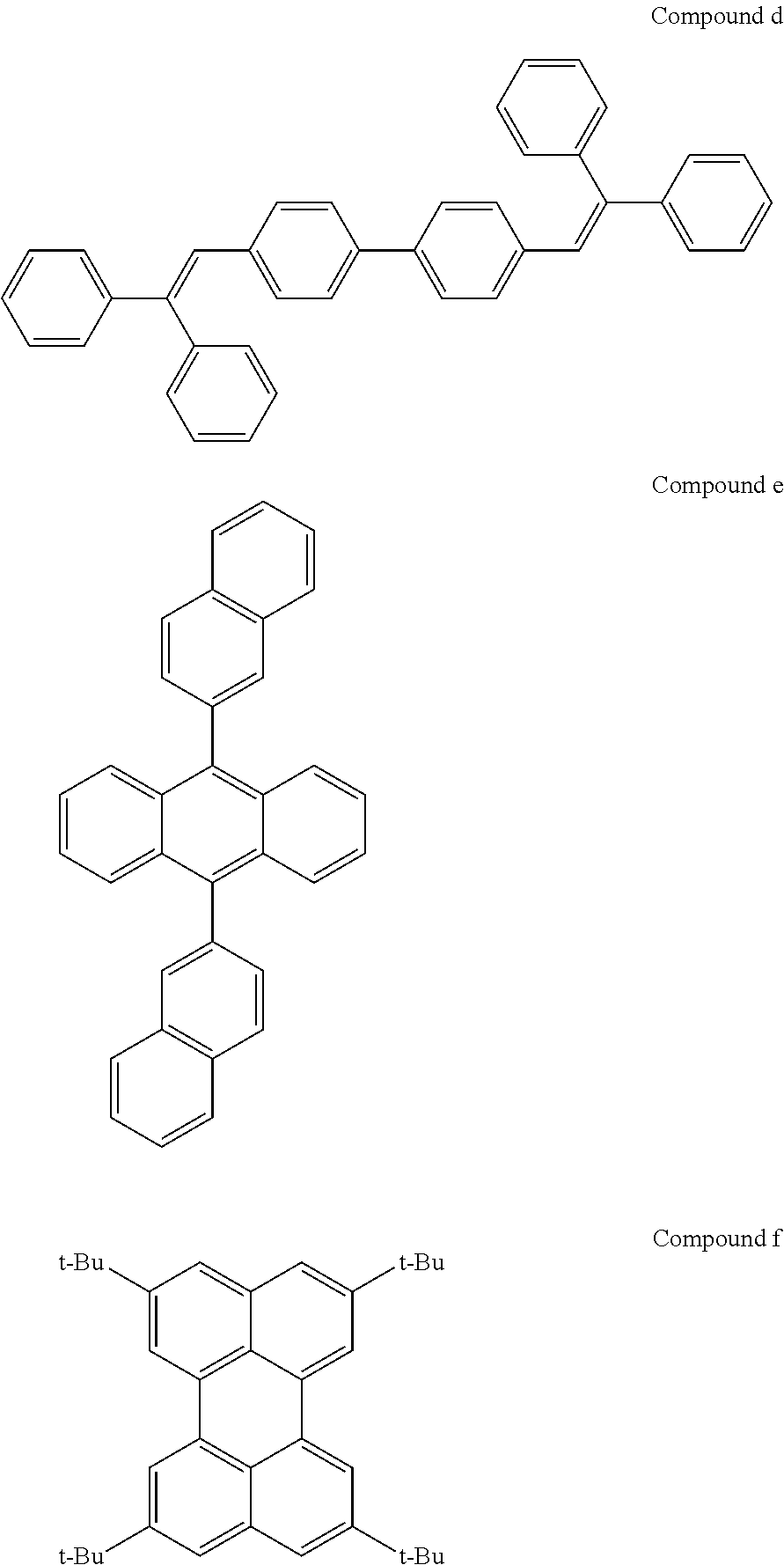Novel compounds for organic electronic material and organic electronic device using the same
a technology of organic electronic materials and compound compounds, which is applied in the direction of discharge tube/lamp details, anthracene dyes, final product manufacturing, etc., can solve the problems of device using these materials in the hole injection or transfer layer, the sky-blue color is not suitable for a full-color display only thousands of hours, and the efficiency and operation life of the device is not good, so as to achieve good operation life, good luminous efficiency, and excellent life properties
- Summary
- Abstract
- Description
- Claims
- Application Information
AI Technical Summary
Benefits of technology
Problems solved by technology
Method used
Image
Examples
preparation example 2
Preparation of Compound 33
[0085]
Preparation of Compound H
[0086]1,3-Dibromo-4,6-diiodobenzene (30.0 g, 61.6 mmol), 2-(2-bromophenyl)-1,3,2-dioxaborane (37.0 g, 153.8 mmol), K3PO47H2O (31.2 g, 92.3 mmol), Pd(PPh3)4 (1.4 g, 1.2 mmol) and DMF were mixed and stirred at 100° C. for 20 hours. After cooling to room temperature, the product was extracted with EA and washed with distilled water. Drying with MgSO4 followed by distillation under reduced pressure and column separation yielded Compound H (7.3 g, 13.4 mmol, 21.7%).
Preparation of Compound I
[0087]Compound H (7.3 g, 13.4 mmol) was dissolved in diethyl ether (2 L) and n-BuLi (26.7 mL, 66.9 mmol, 2.5 M in hexane) was slowly added at 0° C. After stirring for 4 hours, dichlorodimethylsilane (4.8 mL, 40.1 mmol) was added. After stirring for 12 hours at room temperature, distilled water was added. Extraction with diethyl ether followed by drying with MgSO4, distillation under reduced pressure and column separation yielded Compound I (1.4 g...
preparation example 3
Preparation of Compound 40
[0090]
Preparation of Compound K
[0091]3-Bromophenylhydrazine hydrochloride was dissolved in distilled water and 2 M NaOH aqueous solution was added thereto. Thus produced solid was filtered under reduced pressure to obtain 3-bromophenylhydrazine. Cyclohexane-1,3-dione (30.0 g, 267.5 mmol) dissolved in ethanol (1000 mL) was slowly added to 3-bromophenylhydrazine with light blocked. 20 minutes later, the reaction solution was put in ice water. Thus produced solid was filtered under reduced pressure and washed with cold ethanol. Drying under reduced pressure yielded Compound K (46.2 g, 102.6 mmol, 38.4%).
Preparation of Compound L
[0092]Compound K (46.2 g, 102.6 mmol) was slowly added to a mixture solution of acetic acid and sulfuric acid (1:4, 140 mL) at 0° C. After stirring for 5 minutes, the temperature was rapidly raised to 50° C. and then slowly to 110° C. 20 minutes later, after cooling to room temperature, the reaction solution was stirred for 12 hours. Af...
preparation example 4
Preparation of Compound 46
[0095]
Preparation of Compound N
[0096]Phenylhydrazine hydrochloride was dissolved in distilled water and 2 M NaOH aqueous solution was added thereto. Thus produced solid was filtered under reduced pressure to obtain phenylhydrazine. Cyclohexane-1,3-dione (30.0 g, 267.5 mmol) dissolved in ethanol (1000 mL) was slowly added to phenylhydrazine with light blocked. 20 minutes later, the reaction solution was put in ice water. Thus produced solid was filtered under reduced pressure and washed with cold ethanol. Drying under reduced pressure yielded Compound N (46.2 g, 102.6 mmol, 38.4%).
Preparation of Compound O
[0097]Compound N (46.2 g, 102.6 mmol) was slowly added to a mixture solution of acetic acid and sulfuric acid (1:4, 140 mL) at 0° C. After stirring for 5 minutes, the temperature was rapidly raised to 50° C. and then slowly to 110° C. 20 minutes later, after cooling to room temperature, the reaction solution was stirred for 12 hours. After adding ethanol, t...
PUM
| Property | Measurement | Unit |
|---|---|---|
| glass transition temperature | aaaaa | aaaaa |
| chemical | aaaaa | aaaaa |
| organic | aaaaa | aaaaa |
Abstract
Description
Claims
Application Information
 Login to View More
Login to View More - R&D
- Intellectual Property
- Life Sciences
- Materials
- Tech Scout
- Unparalleled Data Quality
- Higher Quality Content
- 60% Fewer Hallucinations
Browse by: Latest US Patents, China's latest patents, Technical Efficacy Thesaurus, Application Domain, Technology Topic, Popular Technical Reports.
© 2025 PatSnap. All rights reserved.Legal|Privacy policy|Modern Slavery Act Transparency Statement|Sitemap|About US| Contact US: help@patsnap.com



